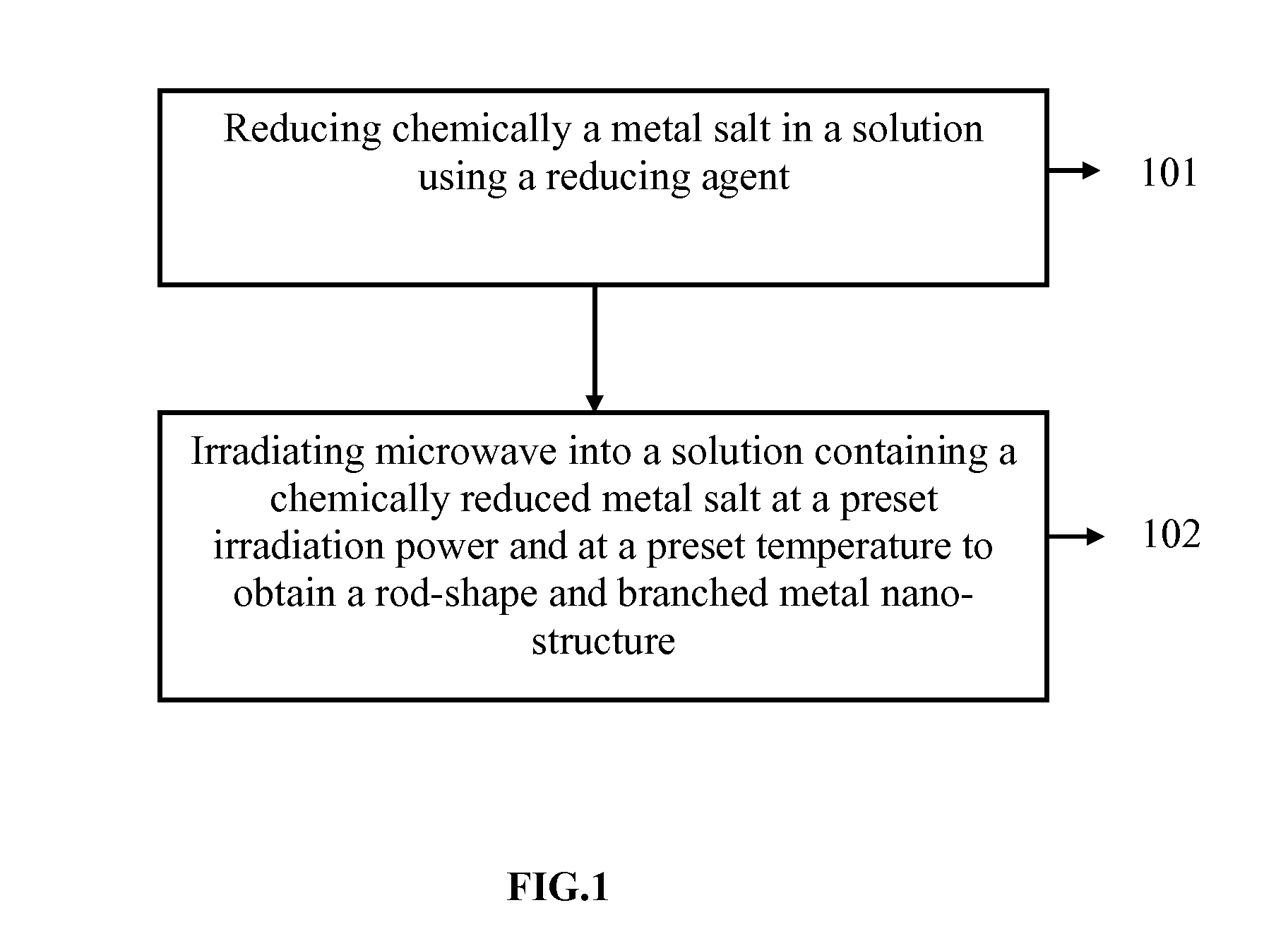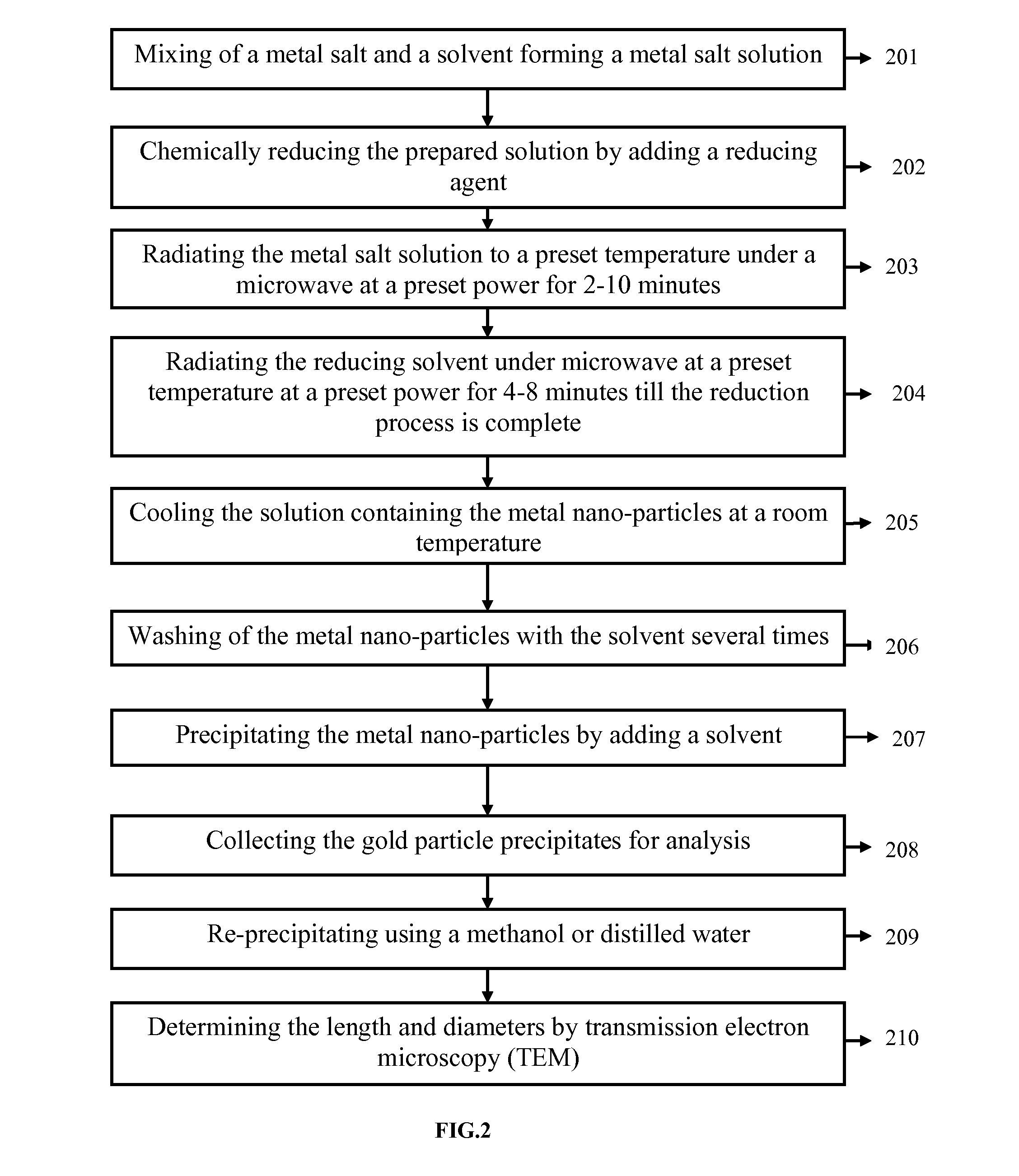Method for producing rod-shaped and branched metallic nano-structures by polyol compounds
a polyol compound and nano-structure technology, applied in the field of producing nano-structures, can solve the problems of difficult to theoretically analyze the cause-effect relationship, easy to scale up, and unsuitable for the large-scale manufacture of gold nano-rods
- Summary
- Abstract
- Description
- Claims
- Application Information
AI Technical Summary
Benefits of technology
Problems solved by technology
Method used
Image
Examples
example 1
[0182]10 ml of 5M HAuCl4.3H2O was mixed with 500 ethylene glycol and polyethylene glycol 1000 to form a mixture solution. The mixture solution was heated to 250° C. under microwave (MW) in a continuous wave (CW) or pulse mode 100% power of 600 W for 2-10 min. Subsequently, the reducing solvent comprising the mixture of polyethylene glycol 6000 and propylene glycol 300 was heated to 200° C. under microwave (MW) in a continuous wave (CW) or pulse mode 100% power of 600 W for 4 min. The mixture was held at 200° C. for 5 min until the reduction was complete (visually, the color of the solution was changed to blue). After the reaction, the solution containing gold nanoparticles was cooled to room temperature. Ethanol was then added to precipitate gold nanoparticles. After washing several times with ethanol, the precipitated gold nanoparticles were collected for analysis. After 2 hours of the reaction, re-precipitation was performed using methanol or DI water. The nanostructures length an...
example 2
[0183]10 ml of 3.5 mM HAuCl4.3H2O was mixed with 500 ml polyethylene glycol 6000 and 500 ml polyethylene glycol 2000 to form a mixture solution. The mixture solution was heated to 250° C. under microwave (MW) in a continuous wave (CW) or pulse mode 100% power of 1000 W for 2-10 min. Subsequently, the reducing solvent comprising the mixture of 500 ml PEG 1000 and 200 ml propylene glycol 300 was heated to 200° C. under microwave (MW) in a continuous wave (CW) or pulse mode 100% power of 600 W for 4 min. (visually, the color of the solution was changed to blue). After the reaction, the solution containing gold nanoparticles was cooled to room temperature. Ethanol was then added to precipitate gold nanoparticles. After washing several times with ethanol, the precipitated gold nanoparticles were collected for analysis. After 2 hours of the reaction, re-precipitation was performed using methanol or DI water. The nanostructures length and diameter was determined by transmission electron mi...
example 3
[0184]10 ml of 2.5 mM HAuCl4.3H2O was mixed with 500 ml polyethylene glycol 1000 and 1500 ml polyethylene glycol 2000 to form a mixture solution. The mixture solution was heated to 200° C. under microwave (MW) heating in a continuous wave (CW) or pulse mode 100% power of 2000 W for 3 min. Subsequently, the reducing solvent comprising the mixture of 500 ml PEG 400 and 500 ml propylene glycol 300 was heated to 200° C. under microwave (MW) in a continuous wave (CW) or pulse mode 100% power of 1000 W for 5 min. (visually, the color of the solution was changed to violet). After the reaction, the solution containing gold nanoparticles was cooled to room temperature. Ethanol was then added to precipitate gold nanoparticles. After washing several times with ethanol, the precipitated gold nanoparticles were collected for analysis. After 2 hours of the reaction, re-precipitation was performed using methanol or DI water. The nanostructures length and diameter was determined by transmission ele...
PUM
| Property | Measurement | Unit |
|---|---|---|
| Temperature | aaaaa | aaaaa |
| Temperature | aaaaa | aaaaa |
| Temperature | aaaaa | aaaaa |
Abstract
Description
Claims
Application Information
 Login to View More
Login to View More - R&D
- Intellectual Property
- Life Sciences
- Materials
- Tech Scout
- Unparalleled Data Quality
- Higher Quality Content
- 60% Fewer Hallucinations
Browse by: Latest US Patents, China's latest patents, Technical Efficacy Thesaurus, Application Domain, Technology Topic, Popular Technical Reports.
© 2025 PatSnap. All rights reserved.Legal|Privacy policy|Modern Slavery Act Transparency Statement|Sitemap|About US| Contact US: help@patsnap.com



